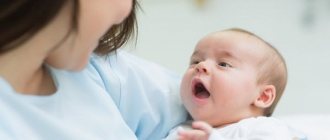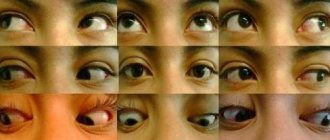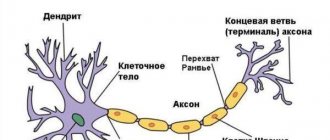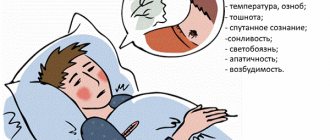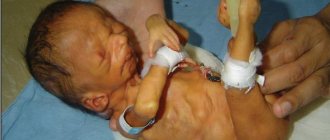Alalia is a severe delay in the development of a child’s speech, not caused by a decrease in hearing or intelligence. It is customary to distinguish sensory and motor forms of alalia. In the sensory form, understanding of speech is impaired; in the motor form, the pronunciation of words and phrases is impaired. But sensorimotor (mixed) alalia is more common.
The diagnosis of alalia usually occurs after 3 years. A child with alalia either does not speak at all or speaks “in his own language.” Often children with alalia exhibit some behavioral traits similar to autism.
The mechanism of occurrence of alalia is still not fully understood. Many experts consider this diagnosis to be lifelong. But alalia can be defeated if you work comprehensively with all neurological dysfunctions.
The Prognoz clinic has been successfully doing this for more than 30 years, which is why our center is often called the alalia clinic.
Main and additional reasons
The main cause of the pathology is organic damage to brain cells, which provokes disruption of the functionality of the auditory and speech analyzer in the upper region of the temporal lobe (Heschl's loop), as well as in Wernicke's area, where the primary processing of sounds occurs.
The main provocateurs include:
- oxygen starvation of the fetus;
- toxicosis in a pregnant woman;
- consumption of alcoholic beverages and drugs;
- brain injury in a child;
- meningitis;
- encephalitis;
- rickets;
- brain tumors.
Causes of sensory alalia in children
Additional factors include:
- infectious and somatic pathologies of a pregnant woman;
- anemia of a pregnant woman;
- entanglement of the fetus with the umbilical cord;
- narrow pelvis of a woman;
- the presence of Rh conflict in the pregnant woman and the fetus;
- maternal endocrine diseases.
Children's hearing does not suffer, but the speech of another person is not perceived. Excitation in brain cells does not spread to other analyzers due to a malfunction of their functionality.
Additional Methods
If a patient has alalia, sessions with a speech therapist are very important. They must be carried out regularly. Speech therapy massage is actively used for speech disorders such as alalia. Treatment is aimed at stimulating the muscles that are involved in the process of sound formation. To do this, massage is performed using fingers or special speech therapy probes.
Physiotherapeutic treatment is also used in children with alalia. Among the main methods are laser, water, magnetic, and acupuncture.
Speech ontogeny
Scientific research has revealed that with sensory alalia, a specific disorder of the auditory analyzer is formed, based on weakness of excitation and inhibition and mild generalization (inconstancy of sound perception).
The main feature of hearing in sensory alalia is considered to be the rapid formation of the inhibition process due to increased functional exhaustion. In pathology, brain cells are underdeveloped. The cessation of their functionality is observed at the level of neuroblasts. Such a disorder can be congenital or acquired, formed in the pre-speech phase.
Dysfunction of the temporal region of the brain
Sensory alalia in children (signs and treatment are described in the article) suggests underdevelopment of brain structures. Morphological disturbance of the temple area causes insufficiency of analysis and synthesis of sound stimuli. For this reason, there is a lack of formation of a connection between sound and object.
In some cases, there is a clear localization of the pathological process in Wernicke's area, located in the left hemisphere. Sometimes a certain area of the lesion is absent, since in addition to Wernicke's area, the functionality of other areas is also impaired.
There are studies confirming that many children did not experience organic brain damage. The data were obtained during electroencephalography. Most modern scientists consider it incorrect to identify the localization of the zone that causes speech loss in an adult with a defect in children.
Bilateral brain damage
The formation of speech centers, according to neurophysiologists, takes place during ontogenesis. Scientists claim that sensory alalia may be a consequence of bilateral damage to brain structures.
This view is supported by the fact that a unilateral disorder, due to the plasticity of the child’s brain and its extensive compensatory capabilities, is not able to cause a permanent speech disorder. Alalia is caused by more extensive organic damage than aphasia.
Main features of correctional work
- The process is primarily aimed at forming a motive, communicative intention, and internal program of utterance.
- Attention is paid to fine motor skills: children learn to color, shade, play with mosaics, tie knots, etc.
- Effective for the development of speech in children with alalia is the use of rhythm and logorhythmics. In these classes, music, speech and movement are combined in various exercises and form speech-motor activity. Memory and personal development of children also develops.
- To activate speech, it is important to practice communication at a level accessible to the child: operations with words (repeat, show, name), phrases and phrase material.
- The development of analyzers – visual, auditory and tactile – is considered important.
- It is necessary to use only the game form of work.
- It is necessary to use visual material: various symbols, environmental materials, pictures, accompaniment of actions with speech, etc.
- The impact should be aimed at the general speech system, clarification of vocabulary, development of phrasal and coherent speech, production of sounds.
Clinical manifestations
Speech is incoherent and unintelligible. The child hears the words spoken by another person, repeats sounds, knows basic words, but is not able to understand their essence.
The main signs of the disease include:
- immunity to sounds;
- extensive use of gestures;
- the presence of active facial expressions;
- the ability to combine two words into one;
- setting the wrong ending;
- skipping letters;
- lack of memorization of words;
- sudden changes in mood and physical activity;
- late speech formation;
- poor vocabulary;
- violation of phonetic norms.
A patient with sensory alalia needs a thorough neurological, psychological and speech therapy examination. The pathology affects approximately 1.5% of preschool children and 0.5% of school children.
The importance and difficulties of diagnosis
Sensory alalia in children (signs and treatment can be determined by a specialist) involves consultation with a psychoneurologist, otolaryngologist, psychologist and speech therapist.
Neurological examination includes:
- Monitoring electrical activity of the brain. It is carried out by placing electrodes in certain areas on the surface of the head.
- Electroencephalography. The electrical activity of the brain is examined by placing electrodes in specific areas on the head.
- Electroencephalography with sleep deprivation. It is suggested to stop sleeping for up to 24 hours to accurately diagnose pathologies in the brain.
- Photo and phonostimulation are used.
- Echoencephalography. Ultrasonic waves are used.
- X-ray of the skull and craniovertebral zone. The study of the internal structure of the brain is carried out using X-rays. The results are recorded on a special film.
- Magnetic resonance imaging of the brain. Nuclear magnetic resonance is used to obtain images of internal organs and tissues.
- Ultrasound Dopplerography of the vessels of the head and neck. Ultrasonic waves reflected in moving red blood cells are measured. A series of pulses allows you to see a graph on the screen showing the speed of blood movement at a certain depth.
The task of the otolaryngologist is to distinguish between sensory alalia and hearing loss. Audiometry and otoscopy are used. A neuropsychologist diagnoses auditory and speech memory.
After the conclusion of medical workers, the diagnosis is carried out by a speech therapist. The specialist establishes perinatal and postnatal anamnesis. The conclusion is based on the distinctive features of the child’s speech and sensory development.
Sensory alalia in children (signs and treatment are described in many scientific works) involves speech monitoring. The connection between object and word, as well as word and action is explored. Diagnosis is based on observation. Attention is paid to the correct construction of grammatical structures and the logic of statements. It is important to limit the disease from hearing loss, autism and mental retardation.
Diagnosis of sensory alalia requires repeated communication with the child and observation of him, since in the same situation children can express themselves differently, demonstrating a good understanding of what was said or a complete refusal to communicate.
Taking into account complex behavioral characteristics, mood instability, irritability, correction of speech impairment differs in duration. The child is very unpredictable, sometimes hysterical and chaotic in his actions.
Sensory alalia is difficult to diagnose, since the pathology is similar to other hearing and speech disorders, as well as systemic types of dysontogenesis.
The cost of a consultation with a neuropsychologist in Moscow will range from 3,000 to 5,500 rubles. In Samara, such a service will cost from 2,500 to 4,000 rubles.
Physiotherapy
Physiotherapeutic methods are aimed at strengthening the body and stimulating the nervous system. These include water treatment (mechanical, temperature or other effects on the body), ultrasound treatment, magnetic field, weak electrical impulses, etc. In any case, regardless of the methods used, the correction must be comprehensive and systematic. Only a neurologist can prescribe these procedures. Since speech is an important and frequently used skill, parents should perform speech therapy exercises at home on their own as directed by a specialist.
Correction and clinical recommendations
Correction of alalia depends on the form of the pathology and is carried out on an individual basis. Therapy involves the help of a speech therapist and related specialists. The treatment regimen is drawn up depending on the health condition and age of the child.
Speech therapy courses
Speech therapy work should begin as early as possible.
Therapy is based on developing correct skills in pronouncing words and constructing phrases, as well as expanding vocabulary.
Classes are based on play, gestures, facial expressions, and rhythmic movements. Includes drawing and imitating animal voices. In the process of mastering non-speech material, the speech therapist begins to develop the pronunciation of vocal sounds similar to simple words with the subsequent complication of the phonemic and syllabic composition.
The child shows interest in the process. The game form contributes to the development of memory, attention and understanding of the essence of objects and their functions.
The table shows the main stages of a speech therapist’s work:
| Stage | Techniques |
| First | Establishing contact with the child, awakening interest in the sounds of everyday life, music, rhythms. |
| Second | Distinguishing non-speech sounds. Musical toys and objects with contrasting sounds are used. |
| Third | Consolidating the relationship between object and sound. The target of correction is vocabulary (passive and active) and enrichment of speech with verbal constructions. The method is based on the preservation of visual perception. Gradually the grapheme is connected. Toys or pictures are complemented with graphic images of letters or words. Vocabulary expansion also occurs when working with text. After reading a short passage, questions are asked to help understand it. Over time, the words that the child is able to read are included by the specialist in the situational text, which involves the use of short sentences and phrases from the dialogue. |
| Fourth | Working with the phonemic language system. The initial stages involve distinguishing vowel sounds and their subsequent inclusion in words. Phrases are composed with these words, which are then spoken and written down. Next, consonant sounds are isolated. The method is based on the differentiation of sounds. |
Speech therapy classes are based on the preservation of higher mental functions, visual perception and kinesthetic development. Classes are held 2-3 times a week. The duration of correctional work is 2-3 years with subsequent observation of the patient. Therapy should be characterized by continuity, intensity and consistency.
Speech therapy massage
The number of procedures is determined by a speech pathologist. It is carried out after a thorough examination of the articulatory apparatus. With proper massage, there is an improvement in the functionality of the child’s nervous and muscular system.
The therapeutic method is capable of:
- optimize the mobility of the speech apparatus;
- normalize the tone of the muscular system;
- increase the volume and amplitude of articulatory movements;
- develop muscle memory coordination for pronouncing complex sounds.
Massage helps strengthen the pharyngeal reflex and develop facial muscles. Mechanical effects on nerve endings have a beneficial effect on the functioning of the speech centers of the brain.
Physiotherapeutic procedures
A special role is given to physiotherapy. During the manipulations, electrical impulses are applied. The procedures are safe and painless.
Among the main methods it should be noted:
- Inductothermy. The method is based on exposure to a high-frequency alternating magnetic field, which promotes the formation of eddy currents. Their energy is transformed into heat, which improves blood circulation and dilates blood vessels.
- Magnetotherapy. The influence of alternating magnetic waves of low frequency is carried out. Computer monitoring involves constant monitoring and makes it possible to create an individual therapeutic program. The procedure helps normalize vascular tone, improve microcirculation and lymph flow, and optimize the functionality of the autonomic nervous system.
- Electrical stimulation. The basis of the method is the use of various pulse currents to stabilize the functionality of nerve and muscle fibers. Electrical stimulation helps maintain the contractility of muscle tissue and creates a flow of nerve impulses that enter the central nervous system.
Psychotherapeutic assistance to families
It involves providing information about the therapy being carried out, motivating parents to engage in long-term joint activities. There is a distribution of responsibility between the speech therapist and the family. Experts prohibit the use of gadgets by children and advise their inclusion in incentive speech activities.
Medicines
Drug therapy involves the use of nootropics and vitamins.
Nootropics help improve cerebral circulation. Among the drugs in this series, Glycine, Vinpocetine, Piracetam, and Cinnarizine are used.
The drug "Glycine" is prescribed for functional and organic disorders of the brain. Children under 3 years of age are prescribed 25 mg of the drug 2-3 times a day.
Patients over 3 years of age are prescribed 1 tablet 2-3 times a day. The course of treatment is 7-10 days. Depending on the indications, therapy can be extended to 30 days. If necessary, the course is repeated after a month. The cost of the drug 100 mg is 36 rubles. There are 50 tablets in a package.
If cerebral blood flow is impaired, children are prescribed 25 mg 3 times a day. The duration of therapy ranges from several weeks to months. The cost of the drug 25 mg is 55 rubles. There are 50 tablets in a package.
Vitamins include Pikovit, Kinder Biovital, Vitrum Baby.
“Alphabet our baby” is prescribed to children aged 1.5 to 3 years, 1 sachet with a meal. The contents of the 3 g package are dissolved in 30 ml of warm boiled water with vigorous stirring for 3 minutes. The solution is prepared before use. Treatment lasts 30 days. The cost of the drug is 460 rubles. There are 45 bags in a package.
The vitamin complex “Vitrum Baby” is prescribed for children aged 3 to 5 years. Take 1 tablet per day after meals. The tablet should be chewed. The duration of treatment is 2-3 months. On the recommendation of a specialist, a repeat course can be carried out. The cost of the drug is 455 rubles. There are 30 tablets in a package.
Alalia in children
General speech underdevelopment (GSD) or alalia is the absence of speech or its underdevelopment, taking into account good hearing and normal intellectual development in a child. The phenomenon is caused by organic disorders of the cortical parts of the brain. Unlike aphasia (a disorder of early formed speech), alalia is characterized by a complete absence of expressive and impressive speech activity. Less often, such children have a poor vocabulary with inarticulate sounds.
Causes
Alalia can be congenital or early acquired in the pre-speech period (in the first three years of a child’s life, when intensive formation of cells in the cerebral cortex occurs). The following factors can lead to intrauterine organic disorders of the speech centers of the brain:
- fetal asphyxia;
- intrauterine infection of a child;
- severe toxicosis during pregnancy;
- threat of spontaneous miscarriage;
- chronic somatic diseases in the mother - hypotension, arterial hypertension, pulmonary dysfunction or heart failure.
The anamnesis of children with this pathology often reveals the participation of not one, but a number of provoking factors. Alalia can develop against a background of fetal hypoxia, aggravated by complications during childbirth, prematurity, premature delivery, or during intracranial trauma in a child due to improper use of instrumental obstetric devices.
Some studies have found a relationship between developmental disorders of the speech center and heredity. Long-term illnesses in children in the first years of life and operations using general anesthesia can lead to the appearance of alalia. Etiopathogenetic causes of alalia (factors that arose in the first years of a baby’s life) include:
- encephalitis;
- meningitis;
- traumatic brain injuries;
- complicated viral diseases – pneumonia, ARVI, influenza;
- rickets;
- malnutrition.
As a result of organic damage to the speech motor analyzer, the child experiences delayed maturation of neurons, which often remain neuroblasts - nerve endings formed at the embryonic stage. As a result of such disorders, the excitability of nerve endings, the inertia of basic brain processes, and functional exhaustion are reduced.
- What is FGDS
- How to insert music into a presentation
- Is it possible to get pregnant before your period?
Classification
There are several types of pathology, which are distinguished by the area of brain damage, the degree and mechanism of development. Official medicine divides the types of alalia according to the Kovshikov system into:
- Motor pathology (Alalia motoria) – abnormal development of expressive speech. The child understands what is being said to him, but it is difficult for him to pronounce the words himself. Motor alalia is further divided into two types, depending on the area of brain damage:
- afferent – damage to the lower parietal parts of the left hemisphere with kinesthetic articular apraxia;
- efferent - abnormal development of the premotor cortex (Broca's center) with kinetic articular apraxia.
- Sensory deviations (Alalia sensoria) – underdevelopment of the impressive type of speech. Pathology occurs when the cortical part of Wernicke's center (posterior superior temporal gyrus) is damaged. The child hears others well, but does not understand their speech.
- Auditory-speech type of deviation (sensorimotor alalia) - the entire sensorimotor area of the cerebral cortex is affected. Children with such deviations not only cannot reproduce sounds, but also do not understand what adults are telling them.
Prognosis for recovery
Sensory alalia in children, the symptoms and treatment of which are determined only with an integrated approach from specialists, represents a systemic speech disorder.
Diagnosis carried out in the early stages of the disease, therapy and rehabilitation courses make it possible to correct the pathology and integrate the child into society to receive a general education. Correction should be carried out from the age of 3-4 years. The formation of speech processes must take place in parallel with the development of mental functions.
The prognosis for sensory alalia is uncertain. The outcome of treatment is influenced by the degree of organic brain damage.
Syndromes included in motor alalia
As mentioned above, motor alalia is a multisyndromic disorder. Let's figure out what's included in it.
- Articulatory dynamic dyspraxia. Children with motor alalia are not able to quickly switch from one articulatory action to another. Therefore, the syllabic structure of words is disrupted. For a long time (often up to 4-5 years), the only possible syllable structure is the repetition of identical syllables: bi-bi, ko-ko, mu-mu, or the naming of the first syllable. Even when a phrase appears, babbling words remain in speech for a long time. With age, this syndrome remains, but manifests itself in words with a more complex structure. Substitutions of sounds, repetitions of syllables, omissions, and rearrangements of sounds and syllables are observed. Errors are irregular, that is, when pronouncing the same word, a child can pronounce it differently each time. At the same time, the number of errors increases as the speech material becomes more complex (while in isolation the child can repeat sounds within the normal range).
- Verbal dyspraxia (this is already the language level). Phonological matrices (the semantic-sound pattern of a word) do not become automated for a long time in case of motor alalia. The phonological organization during the generation of words and phrases is disrupted (essentially this is a problem of planning, that is, dyspraxia of a higher level than just articulation). Each time the child seems to learn to “construct” the word anew, rather than using an established template. It’s not for nothing that the speech of motor alaliks resembles the speech of foreigners, because both of them have difficulties with where to pause, put emphasis, and how to coordinate words in a sentence.
- Articulatory kinesthetic dyspraxia. Here we are talking about violation of sound pronunciation. Moreover, the child can often repeat sounds in isolation without errors, but in the flow of speech the number of errors and substitutions increases sharply. This syndrome with motor alalia may not be present in all children and does not relate to the language level.
- Oral dyspraxia. First of all, dynamic oral praxis suffers, that is, a violation occurs when reproducing a series of movements with the tongue.
- Syntactic violations. The first phrases in children with motor alalia appear after 3 years. At the same time, for a long time, simple, uncommon sentences predominate in speech, and prepositions are often omitted. This is clearly noticeable in tests of composing a story based on a series of pictures, while the child can well understand cause-and-effect relationships non-verbally. This trend continues at school age.
- Morphological dysgrammatism syndrome. Alaliks are characterized by crude agrammatisms. Errors in choosing case endings are common. At the same time, children make more mistakes in dialogue than in monologue (which may be related to the level of self-control).
In children with motor alalia, even after qualitative correction, there is a high probability of agrammatic dysgraphia as a manifestation of language difficulties in writing.
Complications and consequences
Sensory alalia in children is a dangerous pathology that can cause mental retardation. In some cases, personality neuroticism may appear.
These children have:
- isolation;
- uncertainty;
- irritability;
- tendency to cry.
Later, speech disorders have a negative impact on the educational process. Without correction, the development of the child’s psyche acquires the features of intellectual retardation. With a mild degree of pathology, difficulties in mastering speech skills can be traced. Lack of understanding of the addressed speech is an alarming signal.
Sensory alalia in children may be accompanied by symptoms such as a written language disorder (dysgraphia) and a reading disorder (dyslexia). A comprehensive examination and treatment by a neurologist is required. Defects are caused by a failure of mental processes.
Prevention of sensory alalia in children includes ensuring conditions for a favorable course of pregnancy and childbirth, and the early physical development of the child. Timely treatment of pathology helps prevent the occurrence of secondary signs of intellectual disability.
Symptoms
Alalia, the diagnosis of which is a complex process, is sometimes practically indistinguishable from some other diseases. It is important to rule out deafness or mental retardation. With alalia, the activity of certain parts of the brain is disrupted in a child. A huge role is played by damage to two brain structures: the Broca and Wernicke speech centers, which are responsible for the formation of one’s own speech and its understanding.



